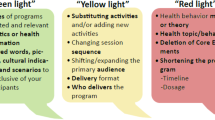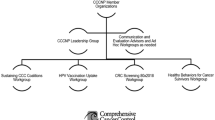Abstract
Introduction
In the early 1990s, a comprehensive cancer control (CCC) approach was developed in the United States (US). In 2003, the US-Affiliated Pacific Islands (USAPI) adopted the CCC approach through a regional coalition, the Cancer Council of the Pacific Islands (CCPI). Using the CCC approach, the CCPI developed jurisdiction-specific cancer coalitions and initiated their respective cancer plans.
Methods
The evolution of the CCC approach and the history of the CCPI regional coalition are reviewed. The outcomes of the regional approach for cancer control in the USAPI are described to illustrate the possibilities, value-added and innovation of using a CCC strategy in a multi-national coalition based in a resource-limited environment.
Results
The CCC approach enabled the CCPI to (1) harmonize cancer control efforts between the six USAPI jurisdictions, (2) represent the USAPI cancer needs as a single voice, and (3) develop a regional cancer control strategy. Outcomes include (1) a regional cancer registry, (2) three sequential regional CCC plans, (3) leveraged resources for the USAPI, (4) enhanced on-site technical assistance and training, (5) improved standards for cancer screening, (6) evidence-based cancer control interventions adapted for the USAPI.
Conclusion
The regional CCPI coupled with the CCC approach is an effective engine of change. The CCC strategies enabled navigation of the political, geographic, cultural, and epidemiologic Pacific environment. The regional partners have been able to harmonize cancer control efforts in resource-limited settings. Regional cancer coalitions may be effective in the global arena for cancer control between communities, states, or countries.



Similar content being viewed by others
References
Given LS, Black B, Lowry G, Huang P, Kerner JF (2005) Collaborating to conquer cancer: a comprehensive approach to cancer control. Cancer Causes Control 16(1):3–14
The Union for International Cancer Control (UICC) ECLE (2012) Supporting national cancer control planning: a toolkit for Civil Society Organisations (CSOs). Geneva
Given LS, Hohman K, Graaf L, Rochester P, Belle-Isle L (2010) From planning to implementation to outcomes: comprehensive cancer control implementation building blocks. Cancer Causes Control 21(12):1987–1994
Centers for Disease Control and Prevention (2016) National Comprehensive Cancer Control Program Logic Model. Centers for Disease Control and Prevention, Online
Comprehensive Cancer Control National Partnership (2018) Comprehensive cancer control national partnership website. https://www.cccnationalpartners.org. Accessed 11 Aug 2018
Hohman K, Rochester P, Kean T, Belle-Isle L (2010) The CCC National Partnership: an example of organizations collaborating on comprehensive cancer control. Cancer Causes Control 21(12):1979–1985
Isle LB, Plescia M, La Porta M, Shepherd W (2010) In conclusion: looking to the future of comprehensive cancer control. Cancer Causes Control 21(12):2049–2057
National Cancer Institute (2018) Cancer control leadership forums. https://www.cancer.gov/about-nci/organization/cgh/research/cancer-control-leadership-forums. Accessed 11 Aug 2018
International Cancer Control Partnership (2018) Developing a NCCP. https://www.iccp-portal.org/developing-nccp. Accessed 11 Aug 2018
Romero Y, Trapani D, Johnson S, Tittenbrun Z, Given L, Hohman K, Stevens L, Torode JS, Boniol M, Ilbawi AM (2018) National cancer control plans: a global analysis. Lancet Oncol 19(10):e546–e555. https://doi.org/10.1016/S1470-2045(18)30681-8
International Cancer Control Partnership (2018) Achieving mesurable progress towards the NCD targets: the importance of National Cancer Control Plans (NCCPs). UICC, online
Pacific Regional Central Cancer Registry (2018) Cancer in the US Affiliated Pacific Islands 2007–2012. University of Hawai’i, online
Palafox NA, Yamada S, Ou AC, Minami JS, Johnson DB, Katz AR (2004) Cancer in Micronesia. Pac Health Dialog 11(2):78–83
Katz AR, Palafox NA, Johnson DB, Yamada S, Ou AC, Minami JS (2004) Cancer epidemiology in the freely associated U.S. Pacific Island jurisdictions: challenges and methodologic issues. Pac Health Dialog 11(2):84–87
Ou AC, Waidubu G, Etheredge GD, Palafox NA (2004) Epidemiology of cancer in the Republic of Nauru. Pac Health Dialog 11(2):101–106
Ou AC, Kienene T, Tenaua K, Etheredge GD, Palafox NA (2004) Epidemiology of cancer in the Republic of Kiribati. Pac Health Dialog 11(2):88–93
Palafox NA, Tsark JU (2004) Cancer in the US Associated Pacific Islands (USAPI): history and participatory development. Pac Health Dialog 11(2):8–13
Gunawardane K, Demei Y (2004) Cancer Council of the Pacific Islands: speaking with one voice. Pac Health Dialog 11(2):14–16
Palafox NA, Gunawardane K, Demei Y (2006) Pacific island partnership: the Pacific cancer initiative. J Cancer Educ 21(1 Suppl):S87–S90. https://doi.org/10.1207/s15430154jce2101s_15
Cancer Council of the Pacific Islands (2015) USAPI Pacific Regional Comprehensive Cancer Control Plan 2012–2017. Department of Family Medicine and Community Health, John A. Burns School of Medicine, University of Hawai’i-Manoa
Cancer Council of the Pacific Islands (2018) Cancer Council of the Pacific Islands. http://www.pacificcancer.org/programs/cancer-council-of-the-pacific-islands.html. Accessed 11 Aug 2018
Nitta M, Tanner C, Narvarte K, Luces P, Silverio A, Zabala R, Navasca D, Sy A, Palafox NA (2015) Policy, system, and environment strategies to promote physical activity and healthy food sources to address Guam’s disparate non-communicable disease burden. J Health Care Poor Underserved 26(2 Suppl):96–103. https://doi.org/10.1353/hpu.2015.0057
Nitta M, Navasca D, Tareg A, Palafox NA (2017) Cancer risk reduction in the US Affiliated Pacific Islands: utilizing a novel policy, systems, and environmental (PSE) approach. Cancer Epidemiol 50:278–282
American College of Obstetrics and Gynecology (2015) Committee Opinion No. 624: cervical cancer screening in low-resource settings. Obstet Gynecol 125(2):526–528. https://doi.org/10.1097/01.AOG.0000460763.59152.9e
Acknowledgments
The authors would like to acknowledge the individuals who were instrumental in founding the CCPI in 2003. They are Dr. Harold Freeman (NCI), Dr. Johnny Hedson (Pohnpei, FSM), Dr. Victor Tofaeono (AS), Dr. Victor Ngaden (deceased—Yap, FSM), Wincener David (Pohnpei, FSM), Dr. Kamal Gunawardane (RMI), Dr. Richter Yow (Yap, FSM), Dr. Livinson Taulung (Kosrae, FSM), Dr. Robin Shearer (CNMI), Dr. Sheldon Riklon (RMI), Jocelyn Songsong (CNMI), Margaret Sesepasara (AS), Dr. Vita Skilling (Kosrae, FSM), Yorah Demei (ROP), Dr. Francisca Soaladaob (ROP), Dr. Kino Ruben (Chuuk, FSM), and Rosalie Zabala (deceased—Guam).
Funding
This publication was supported by Centers for Disease Control and Prevention Cooperative Agreement Numbers 17NU58DP006312 (Pacific Regional Central Cancer Registry 2017–2022), NU58DP006335 (American Samoa CCC 2017–2022), NU58DP006348 (CNMI CCC 2017–2022), NU58DP006269 (Guam CCC 2017–2022), NU58DP006303 (FSM CCC 2017–2022), NU58DP006336 (RMI CCC 2017–2022), NU58DP006289 (Palau CCC 2017–2022), NU58DP005810 (REACH 2014–2018), DP003906 (PRCCR 2012–2017), DP000976 (PRCCR 2007–2012), DP000777 (American Samoa CCC 2012–2017), DP00847 (CNMI CCC 2012–2017), DP000781 (Guam CCC 2012–2017), DP000779 (FSM CCC 2012–2017), DP000826 (RMI CCC 2012–2017), and DP003939 (Palau CCC 2012–2017), along with the National Cancer Institute 2U54CA143727. Its contents are solely the responsibility of the authors and do not necessarily represent the official views of the Centers for Disease Control and Prevention, the National Cancer Institute, or the Department of Health and Human Services.
Author information
Authors and Affiliations
Corresponding author
Rights and permissions
About this article
Cite this article
Palafox, N.A., Given, L., Hohman, K. et al. Comprehensive cancer control planning in the Pacific: the Cancer Council of the Pacific Islands a multi-national regional coalition. Cancer Causes Control 29, 1287–1295 (2018). https://doi.org/10.1007/s10552-018-1115-z
Received:
Accepted:
Published:
Issue Date:
DOI: https://doi.org/10.1007/s10552-018-1115-z




